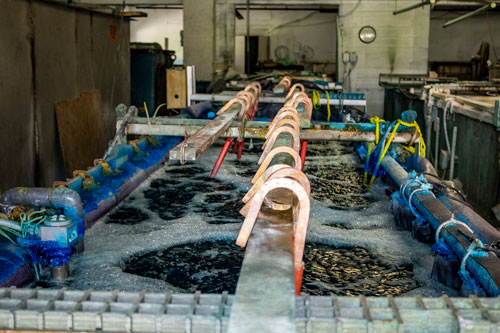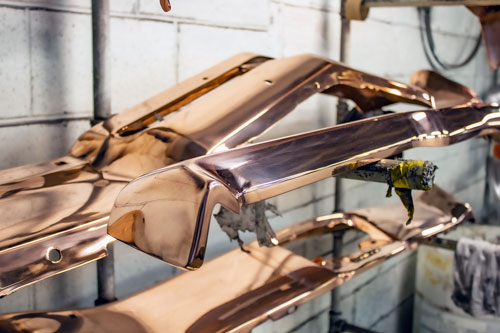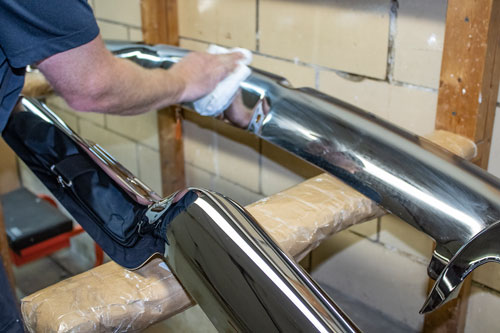 Chrome plating is a process with many steps that are different for each base metal. We electroplate copper, nickel, chromium, or gold onto the part being chrome plated. The basic electroplating process is to dissolve a metal with something and run an electric current through the solution, which pulls the dissolved metal ions out of the solution and onto the part being chrome plated. The parts are connected to copper hooks or racks and are hung into the plating tanks. The tanks vary in size from 1,200 gallons to 3,225 gallons and contain various amounts of acids, bases, metals, organic chemicals, and water. An electric current goes into the anodes, passes through the various solutions in the process, and deposits metal on your part.
Chrome plating is a process with many steps that are different for each base metal. We electroplate copper, nickel, chromium, or gold onto the part being chrome plated. The basic electroplating process is to dissolve a metal with something and run an electric current through the solution, which pulls the dissolved metal ions out of the solution and onto the part being chrome plated. The parts are connected to copper hooks or racks and are hung into the plating tanks. The tanks vary in size from 1,200 gallons to 3,225 gallons and contain various amounts of acids, bases, metals, organic chemicals, and water. An electric current goes into the anodes, passes through the various solutions in the process, and deposits metal on your part.
The chrome plating process is very expensive because of many factors.
- We use A LOT of electricity.
- We must be continuously chemically treating our rinse waters.
 We have constant maintenance, since dissolving metal with acid and running electric current through it is hard on equipment.
We have constant maintenance, since dissolving metal with acid and running electric current through it is hard on equipment.- People need to be paid to work over hot, steaming tanks of acid, metal, and electric.
- Stripping the old coatings from your parts creates hazardous waste that is much more expensive to separate and treat than chrome plating rinse water.
- Regulatory compliance is very time consuming and therefore expensive. In addition to all of the taxes and reporting that goes along with employing 25 people, we also comply with and report to eight government agencies. This includes the Internal Revenue Service, the Environmental Protection Agency, the Occupational Safety and Health Administration, the Department of Transportation, the Department of Homeland Security, the Department of Environmental Protection, the local county, and the local municipality.
- Lastly, the chrome plating only looks as good as the surface that it is put on. The vast majority of our labor cost is in the sanding, buffing, and metal repair, not the chrome plating room.
 The finished chrome plated product that we provide is a brilliant mirror finish that is decorative, provides corrosion resistance, and is easy to clean.
The finished chrome plated product that we provide is a brilliant mirror finish that is decorative, provides corrosion resistance, and is easy to clean.

